The 1924 Trial of Adolf Hitler (the "Beer Hall Putsch Trial")
by Douglas O. Linder
“Our prisons will open and a time will come when today’s accused become the accusers!”—Adolf Hitler, testimony during his 1924 trial
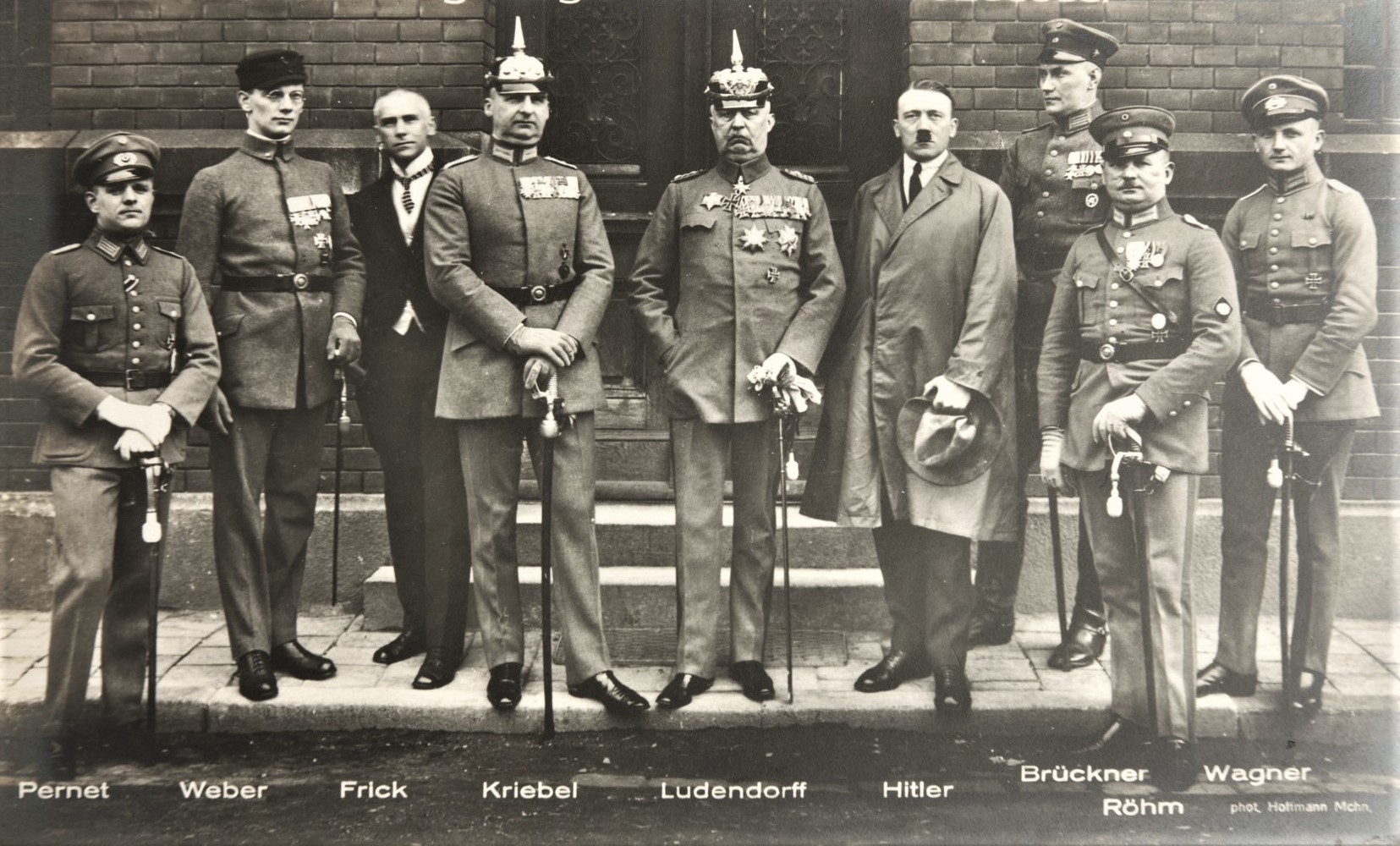
Defendants in the 1924 "Beer Hall Putsch" Trial
If Adolf Hitler had not been tried by the People’s Court for high treason in 1924, the twentieth century might have been very different. Sometimes a trial can provide a defendant with a platform for changing minds. Adolf Hitler knew how to communicate—and when a sympathetic judge provided him the opportunity to showcase his verbal skills and spread his ideas, he took full advantage of the situation. Trials can alter the course of history. And the trial of thirty-four-year-old Hitler for his leading role in the botched 1923 “Beer Hall Putsch” is clearly a prime example of that truth.
1923
In 1923, Germany hit rock bottom. Germany was behind in payments for reparations for World War I—and, in retaliation, French and Belgians had invaded rural parts of the country. There were strikes and sometimes those strikes led to violent responses by German troops. Worst of all, there was hyperinflation caused by the government printing money to make up for lost wages and a sinking economy. It took trillions of marks to equal the value of a single dollar. (In December, the exchange rate was 6.7 trillion marks to a dollar.) With the mark nearly worthless, farmers refused to sell their crops, causing food riots and hunger strikes. In short, the country was a mess.
In the chaos that was Germany in 1923, political groups on both the extreme left and extreme right gained support, while the fortunes of the governing Social Democrats fell. The middle kept shrinking. Communists began winning over 10% of the vote. Far right nationalist groups attacked the democratic government, foreigners, and Jews.
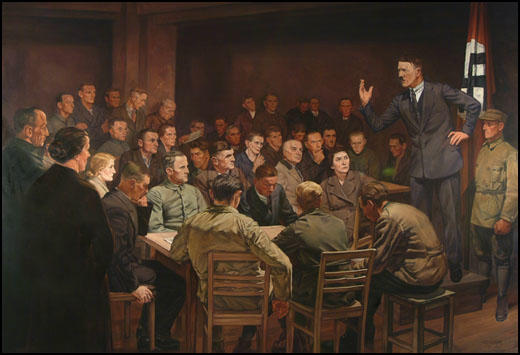
Hitler giving a speech to supporters in a beer cellar (by Hermann Hoyer)
Among the far right groups, one of the most extreme was the National Socialist Democratic Workers Party, the Nazis. It firebrand leader, Adolf Hitler, called democracy a joke, supported the violent overthrow of the Weimar Republic government, pushed for a military build-up, railed against the Treaty of Verailles, talked about restoring German pride, and blamed Jews for much of the country’s misfortune. The party apparatus included a thuggish group called the SA, or storm troopers, which dealt with those who got in the party’s way.
The Putsch
On the morning of November 8, 1923, Adolf Hitler gave Alfred Rosenberg, the editor of the National Socialist Party newspaper, an assignment. Rosenberg was to publish a special edition of the Volkischer Beobachter alerting the foreign press that something—what exactly, was not to be made clear— important was going to happen that evening at the Burgerbrau beer hall, a mile from Munich city center. Hitler told Rosenberg to be at the beer hall at 7:00. Bring your pistol, he told Rosenberg, “the moment for action has come.”
By 8:00, a crowd of about 3,000 filled the beer hall and spilled out into the street. A red Benz pulled up at the entrance. Hitler exited the vehicle, pushed his way through a yelling crowd, and marched into the hall. In the banquet hall, a brass band was playing oompah music and waitresses carrying beer steins swept through tables—tables around which sat many of Bavaria’s leading politicians and business elite.
The scheduled speaker for the night was to be Bavaria’s general state commissioner, Gustav von Kahr, who was to give what had been billed as an important talk. He arrived late and gave a dry speech about the evils of Marxism. Hitler, Rosenberg, and other supporters watched, unimpressed, from a vestibule.
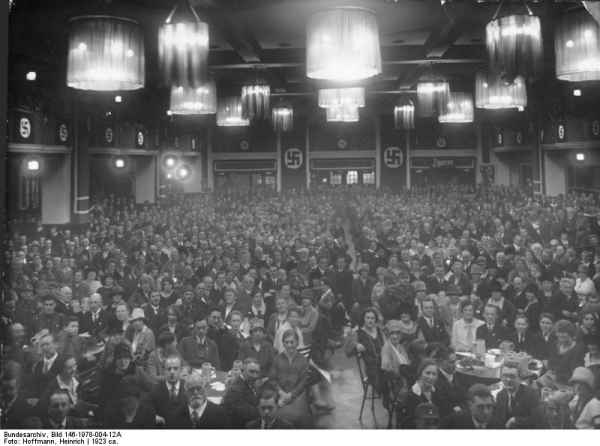
Crowd listens to Kahr speech at the Burgerbrau beer hall on November 8, 1923
Meanwhile, outside the hall, a small army of about 125 men, called the Hitler Assault Squad, was being handed rifles, machine guns, and hand grenades by the unit’s commander, Josef Berchtold. Next to him, wearing a steel helmet adorned with a swastika, was a German war hero and the leader of Hitler’s “protection” force of roughnecks called the Storm Troopers, was Hermann Goring. Berchtold and Goring ordered the men onto four flatbed trucks.
The trucks drove up to the front entrance of the beer hall. Goring and about two dozen men strode quickly into the hall shouting “Heil Hitler!” A hundred or so other men scurried about the hall, covering window, grabbing telephones, blocking exits, and assuming positions along walls.

Storm troopers load into trucks to support the putsch
Hitler took a final slug of beer and marched into the banquet room. He jumped up on a table, pulled out a pistol, and fired two shots into the ceiling. “Silence!” he yelled. Then Hitler and several supporters pushed their way to the front of the room and confronted speaker Kahr at the podium.
Storm Troopers pointed a machine gun at the crowd. Many who were in the audience said later that they suspected they were about to witness an assassination.
Hitler shouted to the crowd, “The national revolution has begun! Six hundred armed men are occupying this hall. No one may leave.” The governments of Bavaria and in Berlin have been overthrown! Army barracks and police headquarters are now under the control of his party! None of this was true, but Hitler hoped and expected that it would be soon enough.
Hitler then told Kahr and two other important political leaders, General von Lossow and Colonel von Seisser, that they should join him in a side room for a conversation about Bavaria’s future. After the men leave, Goering told the crowd, “You all have your beer. Keep drinking! You have nothing to worry about!”
In the side room, Hitler told the leaders that they had a choice. They could join his effort or they could die with him. He told the men his gun had four bullets, one for each of them and one for himself. “If I am not victorious by tomorrow afternoon, I am a dead man,” he said. And then he pointed the gun at his own head. After this disturbing demonstration, Hitler suddenly walked out the room and into the banquet hall. He had an idea.
Hitler told the anxious crowd that his revolution was aimed at Berlin, not Kahr’s regime in Bavaria. He won over the audience, “turning them inside out like a glove” according to one observer. They began to cheer and stomp their approval of Hitler’s plan to begin a march on Berlin.
Hitler returned to his hostages in the side room. He told them the people are on his side; they needed to commit to the revolution. And now he had another card to play, with the arrival in the room of celebrated war hero General Erich Ludendorff, who had been successfully recruited to join his revolution. Ludendorff told Kahr, Lossow, and Seisser that they needed to step up and join “the great national cause.” Kahr replied (though he later denied it), “Your Excellency’s wishes are my orders.”
Hitler brought Ludendorff and the three Bavarian leaders into the hall. They shook hands. Hitler announced that the new provisional government would the next day organize a “march on Berlin, that sink of iniquity.” Shouts of “Heil Hitler!” rang out from the crowd—and then a lively rendition of the national anthem, “Deutschland, Deutschland Uber Alles.”
But the revolution would not happen, at least in 1923. Hitler’s biggest blunder was probably to leave the beer hall about 10:30 and go the Munich’s central train station. His purpose was to investigate a delay by a paramilitary unit in seizing the station to prevent, as one Hitler supporter put it, “the rabble of racial alien Jews from the East from riding away at the last moment in a mad rush, loaded with foreign exchange.” But, while he was away from the beer hall, General Ludendorff, made the critical mistake of releasing the three Bavarian leaders, based on their pledge of loyalty to the cause. Once released, however, the leaders would launch a counter-putsch.
Meanwhile, around Munich, there was confusion and chaos. Nazi shock troops tore apart the offices of a much despised Social Democratic paper, leaving it a smoking ruin. Windows of Jewish-owned shops were smashed. Jews on the streets were robbed or attacked; sixty-four Jews were taken into “provisional custody” at the banquet hall.
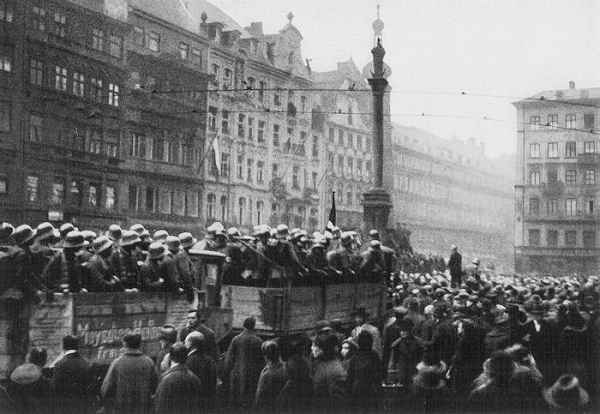
Nazi firebrand Julius Streicher speaking to crowd at Marienplatz in Munich on November 9, 1923
Shortly before 3:00 am, the three released Bavarian leaders ordered all Munich radio stations to broadcast an announcement: “Generalkommissar von Kahr, Colonel von Seisser, and General von Lossow repudiate the Hitler putsch. Expressions of support extracted at gunpoint are invalid.” Kahr issued decrees declaring the Nazi Party illegal, confiscation of all Party property, and the arrest of Hitler, Ludendorff, and other key supporters “on sight.” Newspapers across Munich were ordered not to distribute morning papers on punishment of death. (Bavarian leaders feared that news of their speeches at the beer hall would confuse the public into believing they supported Hitler’s putsch.)
Hitler understood that the tide had turned against his planned revolution. He returned to the beer hall. A New York Times reporter described him as “obviously overwrought and dead tired, a little man in an old waterproof coat with a revolver at his hip, unshaven and with disordered hair.” Things were desperate; government forces were retaking buildings captured by the putschists. But, tired as he was, he and Ludendorff came up with a last-ditch idea. They would leave the hall, march their supporters through the city, and urge citizens to join them. Hitler later would call it, “the most desperately daring decision of my life.”
About noon, the marchers left the beer hall and headed toward the city center, waving their swastika banner and singing their Nazi anthem. As they marched, sympathizers joined them. There was wild cheering from crowds. Fifteen minutes into the march, they reached a bridge over the Isar River, where about thirty members of the state police, armed with machine guns, ordered them to stop. But Hitler’s troops charged, seizing guns and taking twenty-eight police officers captive. The marchers continued on across the bridge, and down narrow streets towards the center of Munich.
With Ludendorff in command, about 2,000 Nazis and supporters headed up Residenzstrasse, a narrow street that led into a major public square, the Odeonplatz (Odeon Square). A commander of a company of state police ordered the marchers to halt as they approached the square, but they marchers continued. And then came the shots; who fired first is a matter of dispute.
Hitler had linked arms with another marcher, Max Scheubner, and when shots hit Scheubner, he fell dead to the ground, pulling Hitler with him. Hitler suffered a dislocated shoulder. Scheubner was struck by bullets in his lungs, chest, right arm, and both thighs. Goring was shot in his thigh and groin. When the firing stopped a minute later, twenty people lay dead in the streets, including fifteen marchers, four state police officers, and a waiter who just took the wrong time to cross the street to work. Another hundred or more people were wounded. The putsch was over—and the round-up of putschists began. (So did repairs; the owner of the beer hall sent a bill to the Nazi Party for 11,344,000,000,000 marks.)
Hitler had an exit plan and executed it. He had arranged for a doctor friend of his to have his yellow Fiat, with its motor running, parked nearby. After the shooting stopped, he ran to the Fiat and was driven to a villa of a friend in Uffing, some thirty-five miles south of Munich. From there, he hoped to escape to Austria. But before he could do so, on November 11, police surrounded the house. Hitler was discovered in the attic, wearing white pajamas and a blue bathrobe and his arm in a bandage.
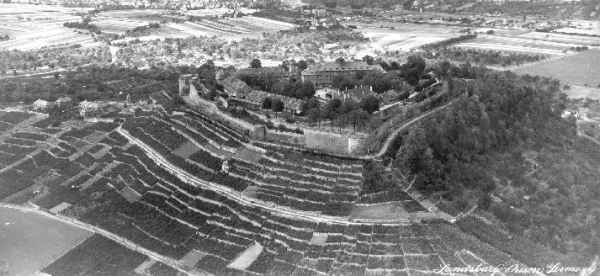
Landsberg prison
Hitler was taken to Landsberg Prison, a tall stone-walled facility 50 miles west of Munich, and placed in what was called “fortress confinement.” This was a lenient sort of confinement that allowed prisoners to wear street clothes, visit cellmates, decorate their cells, entertain visitors, and enjoy five hours or more outside their cells daily. Hitler became Prisoner No. 45, occupant of Landsberg’s best-appointed celebrity cell, Cell 5.
Hitler, though, was despondent. He told the prison psychologist, “I’ve had enough. I’m finished. f I had a revolver, I would take it.” He refused to cooperate with investigators and went on over a week-long hunger strike.
By early December, Hitler was feeling better about things.
The trial would be in Munich before a tribunal of judges, called the People’s Court, not a jury. The tribunal consisted of five judges, and there was no appeal from its verdict. The government settled on ten defendants. In addition to Hitler, defendants included General Ludendorff, Hermann Kriebel (the alleged military planner for the putsch), Wilhelm Frick, Ernst Rohm, Friedrick Weber, Wilhelm Bruckner, Heinz Pernet, and Robert Wagner. All (except Pernet, who was charged only as an accessory) were charged with the crime of high treason. High treason was defined by Article 80 of the German code to be an attempt to subvert the constitution of Germany or its states through violent means. The maximum penalty was life in prison. Interestingly, though four police officers died as a result of the putsch, Jewish citizens were assaulted, and officials of government kidnapped, no charges were brought for any of these crimes.
The Trial
The Bavarian government and Hitler had contradictory goals. Bavaria preferred a quick and low key trial that would attract as little public attention as possible. Hitler, on the other hand, wanted a trial that would allow him to showcase his oratorical skills and promote his views to as wide as audience as possible.
The trial opened on February 26, 1924 in a packed makeshift courtroom on the second floor of the Reichswehr Infantry School. The courtroom included 120 seats, half of which were assigned to the press. Hitler sat at a small table with General Ludendorff. The presiding judge was Georg Neithardt, a right-leaning judge with a stern look and a pointed white goatee. Over the course of the trial, Niehardt will be shockingly deferential to Hitler, allowing him to give long speeches, question witnesses, and (often) interrupt testimony with interjections. The judge’s deference will allow Hitler’s popularity to grow over the 24 days of the testimony and argument.
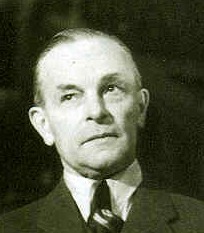
Prosecutor Hans Ehard
Prosecutor Hans Ehard read the indictment, outlining the key events of November 8 and 9. He called Hitler “the soul of the whole undertaking.”
The presiding judge called Hitler to the stand. Consistent with German procedure at the time, the questions came from the judge, not the prosecutor (although they were written largely by the prosecution). In the afternoon session, Hitler gave a nearly four-hour opening statement that dazzled spectators. He began by telling his life story, then shifted to his political vision. He was animated, his voice rising and falling as he laid out his vision of the country’s problems and hopes for the future. He was unsparing in his criticism of racial minorities and left-wing ideologies, calling Communists “not even human.” He blamed the government in Berlin for the economic crisis, saying it had “practically robbed [the people] of their last marks from their pockets.” He said, “Policy is made not with the palm branch, but the sword.” Hitler’s words were reported around the world. Hitler claimed to want only “the best for his people” and said he alone bore “the responsibility and also every consequence” for the failed putsch. He compared the Bavarian leaders who turned on him to a horse “that lost its courage before the hurdle.”
The other nine defendants followed with their own opening statements. For the most part, the judge gave the defendants wide latitude to explain their actions, interrupting only occasionally, such as when putsch military planner Hermann Kriebel labeled Berlin “a criminal government.” General Ludendorff gave about three hours of fumbling, disjointed testimony in which he blamed Marxists, Jews, and the Catholic Church for the country’s problems. The defendants all seemed unremorseful for their roles in the putsch, even wondering why they were being prosecuted at all. Ernst Rohm testified “I still cannot comprehend that I should have to defend myself for a deed that seemed so natural to me.”
When sensitive matters were addressed—matters whose disclosure might be especially embarrassing to the government or suggest a violation of the Versailles Treaty—the court went into secret session. So, for example, Hitler’s testimony that his party’s storm troopers were trained with the knowledge and support of Bavarian authorities, a clear violation of the Treaty, was never heard or reported by the international press.
Defense lawyer Karl Kohl, the most aggressive member of the defense team, tried to turn the tables and put the government on trial. Kohl called the bloodshed at the Odeonplatz “murder,” and suggested it was the three Bavarian leaders, Kahr, Seisser, and Lossow that should really be on trial.
After six days of opening statements by the defendants, the first witnesses took the stand on March 4. As various police and government witnesses testified, it became increasingly clear that the judge’s main goal was in protecting the reputation of the Bavarian leaders and the institutions they ran. He was happy to let defense attorneys and defendants rant all they wished about foreigners, Marxists, and Jews, and he tolerated criticism of the government in Berlin, but the judge considered personal attacks on the Bavarian leaders out of bounds.

Trial judge Georg Neithardt (in dark hat)
Each of the three Bavarian leaders testified. The first was General Otto von Lossow who admitted to taking serious issue with the government in Berlin. But, unlike Hitler, his plan had been to rescue Germany form its “impossible conditions” through legal and constitutional means, not revolution. Lossow admitted to having several conversations with Hitler before the putsch, but said the goal of those talks was to bring the fiery Hitler “down to earth.” Lossow said he resented Hitler’s actions because they derailed his own plans for a patriotic effort to reshape the German government. Lossow testified he never intended to be part of Hitler’s putsch and, on the way out of the beer hall, had told the other leaders to “Put on an act!”
Cross-examination of Lossow got out of hand when the judge refused to allow a question Hitler wanted to ask of the witness. Hitler shouted, “Far be it from me to criticize the court,” and then went on to call what happened on November 8 the “product of the treasonable activity of Lossow, Kahr, and Seisser.” The judge told Hitler, “You have no right to criticize in this way.” Hitler then leaped to his feet, screamed at the witness, then, according to a reporter present, collapsed back into his seat “as if from a physical blow.”
Gustav von Kahr seemed tense during his testimony. He said he felt “rage” when Hitler stormed his rally and believed that the putsch could have led to a “staggering catastrophe” for the country. The actions he took that night, his seeming willingness to cooperate with Hitler, was all, he said, an effort to avoid a bloodbath.
Hans Ritter von Seisser, the last of the three Bavarian leaders to testify, said that Hitler was a young man who led the applause of crowds go to his head. He testified that in a meeting with Hitler on November 1, Hitler had promised him, “I will make no putsch, I promise you that.” Exactly a week later, he did just that. Seisser blamed Hitler for setting back years of work in promoting the nationalist cause. Hitler became annoyed with the colonel’s testimony, saying at one time in a loud voice, “What insolence!” Seisser responded by demanding that the judge reprimand Hitler. A shouting match, lasting perhaps ten minutes, followed, with the judge finally admonishing Hitler for his remarks.
In his closing argument for the prosecution, Ludwig Stenglein told the court, “A high, perhaps morally legitimate goal dos not justify the use of criminal means.” Overall, it was a strikingly weak argument that David King, in his The Trial of Adolf Hitler, described as sounding “like an apology, or even a eulogy.” He even praised Hitler’s “honest efforts to inspire belief in the German cause.” And said, “As human beings, we cannot withhold our respect from Hitler.”
Hitler’s defense attorney, Lorenz Roder, argued that Hitler had collaborated with Bavaria’s top leaders, and that working with the state’s highest civil and military authorities could be no crime. He urged the tribunal to acquit his client and thereby allow “a man, who has stood up with every fiber of his being for the German people, the German state, and German greatness, to keep doing so.”
On March 27, Hitler gave his final statement, as defendants were allowed to do under German law. Hitler told the court that his goal was never to become a minister. Instead, “I wanted to be the destroyer of Marxism.” He said he was “born for politics” and just as “a bird must sing because he is a bird,” he had to engage in a political life. He felt he had the duty to step forward and save Germany. The putsch was not a failure, Hitler said. “On the contrary, it raised people to the highest pitch of enthusiasm.” He predicted “the hour will come” when “the masses who stand in the streets under our swastika flag will unite with those who fired at us on November 8.” He said, “The army we have formed is growing from day to day.” Hitler’s words moved a number of people in the courtroom to tears.
Hitler argued that the government was prosecuting the wrong people: “For it is not you, gentlemen, who pronounce judgment upon us. Instead, the judgment of the eternal court of history will pronounce against this prosecution which has been raised against us.”
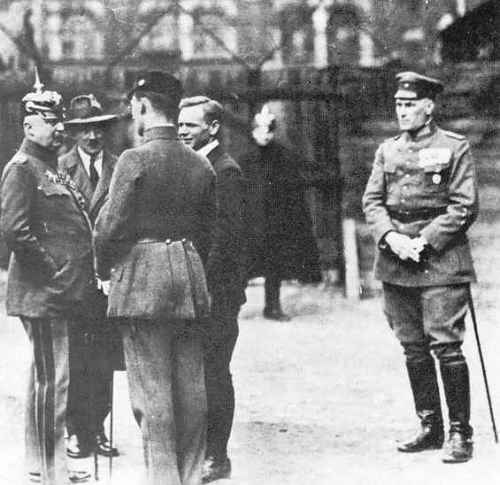
Hitler and other defendants chatting on the last day of trial
After Hitler finished his speech, Judge Neithardt announced, “The trial is concluded.” He saidy that “judgments will be handed down at 10:00 a.m. on April 1.”
Hitler and three of his co-defendants (Kriebel, Phohner, and Weber) were found guilty and sentenced to five years in prison, the absolute minimum sentence for convictions. And, each man would be eligible for parole in only six months, with a further reduction for time served. Five other defendants were found guilty only of aiding and abetting high treason, and were placed on probation. General Ludendorff was acquitted of all charges.
Neithardt said that the lenient sentences were justified by “the purely patriotic” and “noble” and “unselfish” motives of the defendants.
Neithardt also announced that Hitler would not face deportation from Germany even though the law mandated just that for all foreigners (and Hitler was an Austrian citizen, not German) convicted of high treason. The judge simply ignored the law, noting that Hitler “considers himself to be German” and had served in the German army during World War I. The judge’s announcement brought cheers from spectators.
After announcement of the verdict, Hitler was taken to a second-floor room to await transport back to prison. He walked to the window and waved to the crowd below. The crowd gave him a loud ovation. Cries of “Heil Hitler!” rang through the streets.
Trial Aftermath
Not everyone was pleased with the trial. One German reporter called it “a great political carnival.” He noted that the court had allowed Hitler the unprecedented leeway to make long propaganda speeches and that the judge showed shocking sensitivity to the concerns of the defense, as when the judge banished a cartoonist from the courtroom because his caricature of one of the defendants had not been to his liking. The Times of London editorialized, “The trial has proved that a plot against the Constitution of the Reich is not considered a serious crime in Bavaria.”
The Nazis would score a big victory in the spring elections. Three of the ten defendants were elected to the Reichstag.
Hitler enjoyed remarkable freedom and privileges at Landsberg Prison. He was served breakfast on a table with a white tablecloth by his fellow prisoners. Afterwards, he could sip coffee and have toast with marmalade in a nearby wicker chair. He laughed as he watched prisoners engage in boxing matches. He had access to the prison library and gardens. He enjoyed strolling down a lane past flowers and fruit trees so much that the lane became known as “the Hitler Path.” In his cell, he sketched and designed stage sets for Wagner operas. The evening ended with the singing of nationalist songs, often accompanied by the prison band.
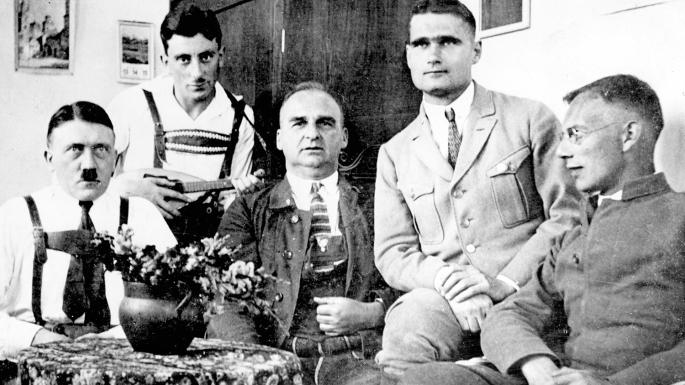
Adolf Hitler and fellow prisoners (including Rudolf Hess, second from right) at Landsberg Prison
By July, Hitler was hard at work on a work that would be both autobiography and political manifesto. The completed work would be called Mein Kampf. It would be 782 pages long, and it would sell twelve million copies by 1945. In the book, Hitler developed the two great themes that would mark his later career. First, he defined world history as a struggle between races and saw Aryans as the culture-creating race and Jews as the culture-destroying race. Second, he lays out a case for the imperative of German territorial expansion to the east—he called it living space for Germans, or Lebenstraum.
On December 19, the Bavarian Supreme Court ruled in favor of Hitler’s parole. Hitler was released the next day. He said, “When I left Landsberg, everybody wept—but not I.” Hitler said his time in prison gave him “that fearless faith, that optimism, that confidence in our destiny, which nothing could shake thereafter.” He said that the prison stay had given him “a frenzy of liberty” and that “without my imprisonment, Mein Kampf would not have been written.”
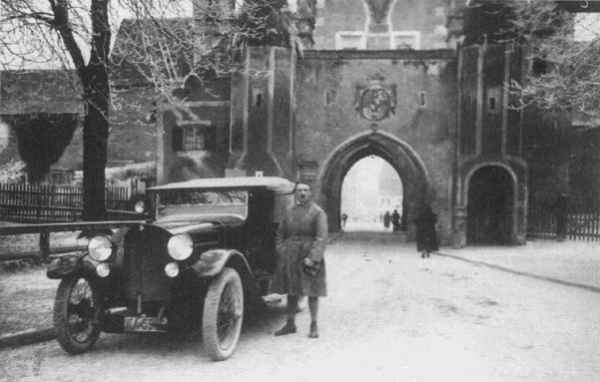
Adolf Hitler, on the day he was released from Landsberg Prison, December 20, 1924
Hitler’s release, just eight months into a five year sentence, left unanswered the question of how history might have been very much different if Hitler had been held in prison for a term more appropriate for his crime.
The trial had made Hitler, formerly a relatively minor regional player, into a patriotic martyr and a prominent figure on the national stage--a stage from which he would eventually have the power to inflict suffering unlike any the world had ever seen. Nine years after his trial, Adolf Hitler was Chancellor of Germany.
